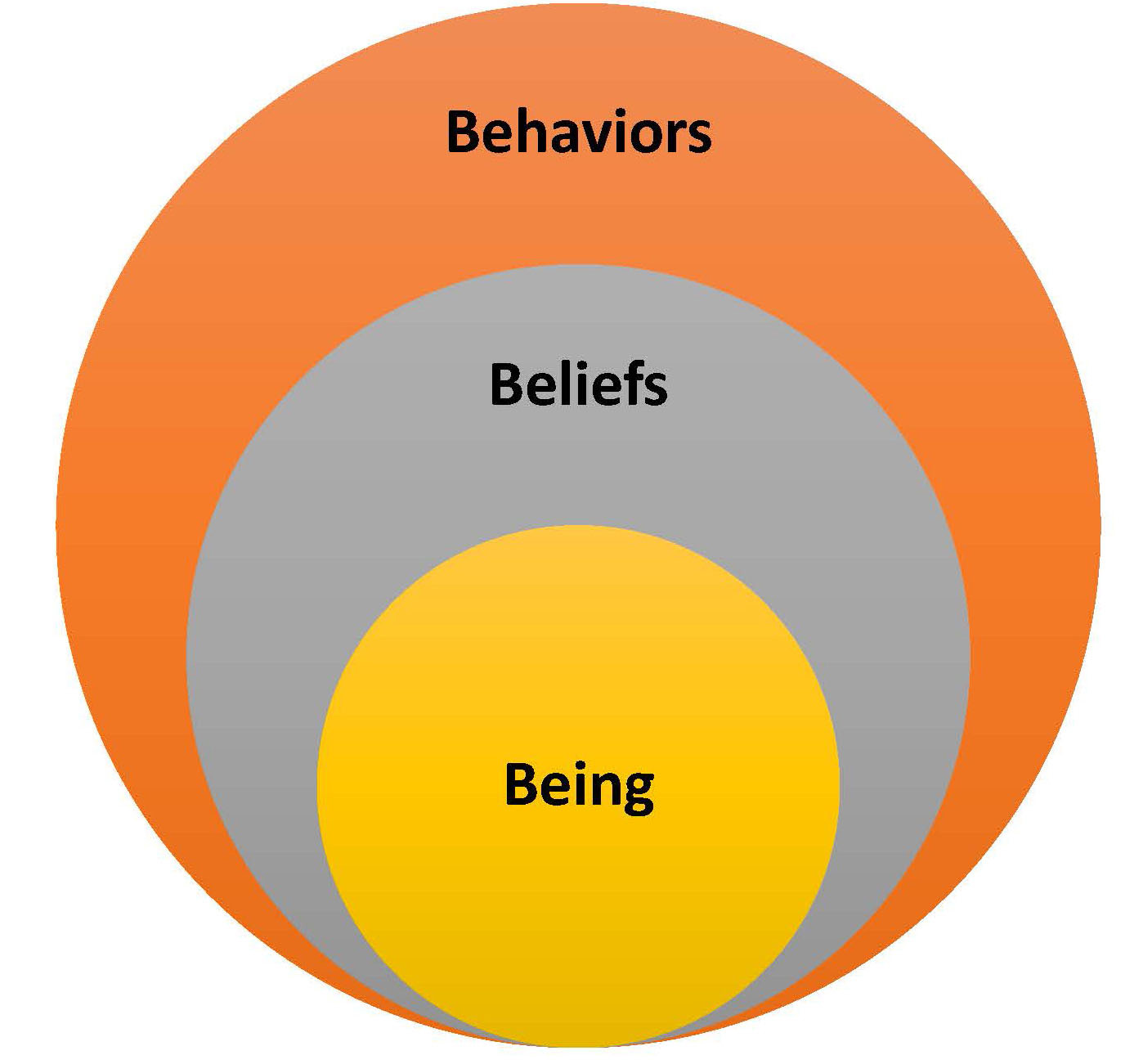WHAT IS TRANSFORMATIONAL COACHING?
Transformational coaching is a method of reshaping the inner person through transformational changes that a person initiates through a process of reflection.
In order to fully understand this topic, you must first know that transformational coaching is not about achieving goals. It is aimed at improving proactivity and strategies. You can then use it to achieve your goals, as an individual or in a team. Transformational coaching focuses on BEING and not DOING. This means that it is a method that strives for the inner development of the human being himself and not so much for the fulfillment of that person’s desires. The starting point of the method is that the person looks at what he or she wants to become.
In order to apply this method effectively, you must first know what personal transformation is and why it is important.

Transformational coaching: transformation and change are not the same
Every individual goes through certain situations in his or her life that bring about change. At some point, you may ask yourself whether these changes are the result of positive or negative actions in the way you live your life. Changes can lead to positive situations, but also to situations with boisterous or negative results. A change does not automatically mean a transformation. Many people regularly change things in their lives, from large to small such as:
- changing daily habits, for example getting up at 5:00 am instead of 9:00 am. Someone can make that decision if he or she wants to have a more productive day.
- Someone moves to another country, gets to know the culture and language of the new country. However, these are changes that are necessary for the person to adapt to a new environment.
So people are constantly changing as a result of the decisions they make. These decisions lead to actions, and these actions, however insignificant they seem, have positive or negative consequences. However, transformation is something that you don’t often experience. It goes beyond our daily worries.
Transformation is an inner thing that rarely occurs. It means that someone has gone through a difficult or complex process or situation in his or her life that has left psychological traces.
This is why transformation is something that doesn’t happen often, but it has a radical effect.
TRANSFORMATIONAL COACHING IS AIMED AT “BEING”
The transformational coaching method is intended to help people change in a more sensitive and supportive way. Many people in that situation feel that they have lost their way, or that they have to break through bad habits, patterns, and negative behaviors in their lives that are hindering the development of their skills or potential.
In order to carry out the transformational coaching process, the coach must help identify and interpret this past behavior that prevents the person from developing positively. This behavior can continue to occur in the future if someone is not aware of it. Transformational coaching is also the way to achieve the transformation that the person needs. Self-discovery and self-awareness help you find a goal, such as achieving certain things.
By discovering who you really are and what you want to achieve, the dreams and goals come together in transformational coaching. The coach then guides him or her in the process to make this happen.
THE 5 STEPS OF TRANSFORMATIONAL COACHING
Five steps are generally distinguished in the transformational coaching method:
Step 1: recruitment
It is imperative to attract the right coaches for the changes that the company or individual wants to make through the coaching process.
Step 2: listen
During this phase, the coach must listen carefully and give the others the opportunity to express themselves in order to get to know their thoughts and emotions basically. By listening carefully, the coach can gather relevant information, ask the right questions and help the person in question reflect.
By listening, you can identify actions, behaviors and emotions that can aid in the transformation.
Step 3: Explore
During this phase, inner exploration is indispensable to assist the person in his or her transformation. Exploring thoughts can help identify why the person is exhibiting certain behaviors that interfere with them at work or in their personal life.
In this phase it is important to ask penetrating questions that invite you to reflect on emotions.
Step 4: Action
This phase is about resolving internal conflicts and how they can be addressed with positive behavior. It is important for a coach to encourage a person to practice positive behavior. He or she must also learn to deal effectively with difficult situations in life, for example at work. How do you deal with stressful situations when you work in a team, how do you analyze and reflect internally so that you can show a positive result as a team.
Step 5: assessment
The final stage is to assess the coaching session based on the results achieved with regard to the person’s feelings and how they positively or negatively influence his or her behavior.
Transformational coaching is about emotions, beliefs and thoughts. The purpose of the process is to identify specific events that the person has experienced. What actions have these events led to in his or her life and to what extent do they determine his or her current behavior? It addresses the question of how you can develop new, positive patterns for your private life and at work and how you want to see yourself in the present and the future by transforming your behavior.
The role of the coach is self-discovery and personal development
The guidance and knowledge of the coach help to determine and explore the inner life of the individual in a personal way. After self-discovery, the following question must be asked: what does it take to achieve the desired goals? The premise of the transformational process is to interpret people’s beliefs, interpretations and goals. It is examined how they have experienced this in their lives and what the results achieved are.
Click here to read more about transformational coaching.
Maybe you will love this link to. Click here.
The role of the transformational coach is to assist folks modification and transform their dangerous habits. New skills that the person didn’t have before area unit developed. certainty could be a essential think about personal self-exploration. It permits the person to mirror on the ‘me’ in daily actions approach} behavior is reworked in an exceedingly positive way permanently results once the specified goals are achieved.
Benefits of transformational work
• Giving direction to attain positive results.
• Helps interpret the person’s choices and behavior throughout his or her life thus far.
• Helps to focus choices and behavior towards realizing what the person desires to attain.
• The coach helps to alter interpretations once they aren’t any longer required.
• Helps to utilize the individual’s full potential. With the on top of effects, a metamorphosis will surface that may cause higher behavior that may end in the specified and expected outcomes for the person. the method started with the intention of achieving results. thus there should be a positive transformation that ends up in behaviors that may cause bigger well-being in life.
Coaching is often geared toward a positive outcome in achieving the goals. it’s an honest thanks to address problems that the person desires to check modified which he or she desires to play a vital role within the gift. The results should be measurable to be ready to check however the method is progressing. Tangible indicators for achieving objectives area unit necessary.
These area unit thus not forgotten during this sort of work, as they provide a lot of security to the person in question and provides them confidence in their transformational method. additionally, the coach and therefore the person themselves will confirm on the premise of those indicators once the target has been achieved.
Transformational Life Coach
The role of the coach isn’t to impose demands on the one who desires to remodel, or to pressure him or her to try to to it at a definite pace. The coach could be a companion United Nations agency invitations self-reflection and guides the person on his or her path of find. Without deciding and while not overshadowing the person, the coach helps him or her categorical wishes and needs as somebody’s being.
Guiding and observance the processes of up and developing their skills so as to attain personal success. The equal work relationship is important for a lot of trust. as an example, the coach will facilitate establish negative, harmful thought patterns and routine, restless behavior. Transformational work will modification somebody’s life. The modification starts from at intervals then that modification is mirrored in modified daily behavior.
The focus of the coach is thus on inner growth and serving to with the exploration of one’s temperament because the propulsion behind behavior. Being affects doing. The person can initial need to get to understand themselves so as to be ready to form the most effective behavior for his or her life. In outline regarding transformational work Transformational work focuses on people’s spirituality, their BEING in respect to what motivates them in life. the tactic is employed to show folks to mirror and take matters into their own hands, with the aim of absolutely remodeling behavior and emotions for private and skilled success.
This type of work is especially used once somebody feels lost or once an organization determines that staff ought to work on the means they act with one another. standard of living will cause folks to urge stuck in their temperature and behavior to repeat and be seen as traditional. The results of that behavior isn’t continually positive and may conjointly cause negative patterns that hinder folks in their personal development.
The method of transformational work invitations you to figure on shaping and learning new changes that may cause transformation so as to feel happier and a lot of positive, with an eye fixed for the deepest interior of the individual. Now it is your flip What does one think? Is transformational work necessary for contemporary firms that wish their staff to treat one another otherwise to forestall staff from losing their ‘self’?
Share your information and knowledge via the comment field at rock bottom of this blog article. Thank you!


